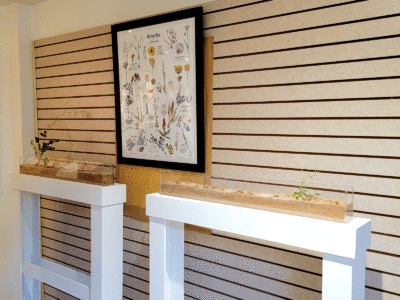By VERNON ROBISON
The Progress

A thought-provoking artwork is now on display for a time at the Lost City Museum in Overton. The work, by Phoenix-based artist Jen Urso was installed at the local museum on Tuesday, July 11 by Katie Hoffman and Rayette Martin, both of the Nevadans for Cultural Preservation (NVFCP) organization.
Urso’s artwork comes to Lost City Museum from an earlier exhibit at the Marjorie Barrick Musuem of Art at UNLV, for which it was created. Called Modern Desert Markings: an Homage to Las Vegas area land art, this exhibition was a collaboration between the Barrick Museum and the NVFCP organization.
The exhibit brought together a group of contemporary artists to inspect, critique and interpret five historic works of land art located in the deserts of Southern Nevada. A series of field trips took the artists to the sites of several land artworks from the 1960s and 1970s. Gaining inspiration from these earlier works, the artists were then to create new works that reflected their feelings and views about the land art they had seen.
Urso’s work is a reaction to Michael Heizer’s Double Negative, a mammoth piece still located on the east edge of the Mormon Mesa, only about 8 miles from the Moapa Valley community.
Heizer’s work, created in 1969, consists of two ends of a 1,500 foot long trench – 30 feet wide and 50 feet deep – spanning across a naturally-eroded curve in the edge of the mesa.
In an interview last week with The Progress, Urso explained her reaction to the visit to Heizer’s work.
“I was really thinking about all of the kind of damage that Michael Heizer to the biome and the natural environment,” Urso said. “It seemed like such an aggressive act on the landscape. And I can’t even imagine anybody being allowed to do something like that now.”
Urso said that she is also an avid gardener. That gardner role kicked in during the visit to Double Negative, she said.
“I was just thinking about what was in all of that disrupted soil,” she said. “In the desert there are so many dormant seeds just waiting out there in the soil for the rains to arrive. When the moisture hits them everything just goes crazy. But it is certainly not dead before that. It is just not active yet.”
Urso decided to collect some of the soil from the Double Negative site. She took it back home with her and began to cultivate it in various ways to see what would grow naturally.
“Since I am a gardener, I am thinking about that soil and how important it is,” she said. “I am trying to kind of heal the soil and get it to be healthy and everything.”
As a reference to Heizer’s work, Urso created two planter cases to contain these soils. Long, narrow rectangles in shape, these lucite clear cases are built in precise miniature scale to the trenches of Heizer’s piece in the desert. The two cases are placed side by side with a gap of negative space in between them, similar to the larger work they reflect.
Then posted on the wall behind and above that gap, is a framed work showing beautiful and intricate drawings, done by Urso, of a variety of desert plants, natural to the area of Double Negative.
Urso was uncertain what, if anything she would get when she began watering these seemingly barren desert soils.
“I really didn’t know what would grow,” she said. “I thought potentially that it could just end up being a container of dirt sitting in a gallery. And that would be okay too.”
But it wasn’t long after water had hit the soil in the UNLV museum space that living things began to sprout and grow.
“It was really an exciting development,” she said. “I was getting updates from the staff all the time, sending me pictures.”
Interestingly, one of the more prominent plants that grew was a invasive weed: a Saharan Mustard plant. “That was something,” she said. “It is not necessarily a good sign, but it was what was there.”
Other plants had come and gone during the time on exhibit at the Barrick Museum. One of the plants that was just beginning to take hold last week was identified as a desert chicory, a desert wildflower variety.
“I am kind of curious to see what is going to happen now in its new home there in Overton,” Urso said. “And there are definitely other seeds in that soil that just haven’t sprouted yet.”
Urso’s work will be on display at the Lost City Museum for the next couple of months and into September.
The museum is located at 721 S. Moapa Valley Blvd, on the south end of downtown Overton. It is open Wednesdays through Sundays from 8:30 am to 4:30 pm. Admission is $6 for adults and seniors. Children 17 and under are free.








![ElectionAd [Recovered]2](https://mvprogress.com/wp-content/uploads/2024/05/4-24-2024-FC-ElectionAd-Finalv3.jpg)

